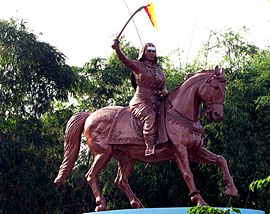Kittur Chennamma facts for kids
Quick facts for kids
Kittur Rani Chennamma
|
|
|---|---|

Statue of Rani Chennamma in Bengaluru
|
|
| Born |
Chennamma
23 October 1778 Kakati, Belagavi District, present day Karnataka, India
|
| Died | 21 February 1829 (aged 50) Bailhongal, Bombay Presidency, Company Raj
|
| Nationality | Indian |
| Other names | Rani Chennamma, Kittur Rani Chennamma |
| Known for | 1825 Revolt against the British East India Company |
Kittur Chennamma (23 October 1778 – 21 February 1829) was the Indian Queen of Kittur, a former princely state in present-day Karnataka. She led an armed resistance against the British East India Company in 1824, in defiance of the Paramountcy, in an attempt to retain control over her dominion. She defeated the Company in the first revolt, but died as a prisoner of war after the second rebellion. As one of the first and few female rulers to lead kittur forces against British colonisation, she continues to be remembered as a folk hero in Karnataka, she is also an important symbol of the Indian independence movement.
Early life
Kittur Chennamma was born on 23 October 1778, in Kakati, a small village in the present Belagavi District of Karnataka, India. She belonged to the Lingayat Panchamasaali community and received training in horse riding, sword fighting and archery from a young age. She married Raja Mallasarja of the Desai family at the age of 15.
Rebellion against the British
Chennamma's husband died in 1816, leaving her with a son and a state full of volatility. This was followed by her son's death in 1824. Rani Chennamma was left with the state of Kittur and an uphill task to maintain its independence from the British. Following the death of her husband and son, Rani Chennamma adopted Shivalingappa in the year 1824 and made him heir to the throne. This irked the East India Company, who ordered Shivalingappa's expulsion. The state of Kittur came under the administration of Dharwad collectorate in charge of St John Thackeray of which Mr Chaplin was the commissioner, both of whom did not recognise the new rule of the regent, and notified Kittur to accept the British control.
This is seen as a foreshadowing of the later Doctrine of lapse introduced by Lord Dalhousie, Governor General of India, to annex independent Indian States from 1848, a doctrine based on the idea that in case the ruler of an independent state died childless, the right of ruling the State reverted or "lapsed" to the suzerain.
Rani Chennamma sent a letter to Mountstuart Elphinstone, Lieutenant-Governor of the Bombay province pleading her case, but the request was turned down, and war broke out. The British placed a group of sentries around the treasury and crown jewels of Kittur, valued at around 1.5 million rupees upon the outbreak of war in order to protect them. They also mustered a force of 20,797 men and 437 guns, mainly from the third troop of Madras Native Horse Artillery in order to fight the war. In the first round of war, during October 1824, British forces lost heavily and St John Thackeray, collector and political agent, was killed in the war. Amatur Balappa, a lieutenant of Chennamma, was mainly responsible for his killing and losses to British forces. Two British officers, Sir Walter Elliot and Mr Stevenson were also taken as hostages. Rani Chennamma released them with an understanding with Chaplin that the war would be terminated but Chaplin continued the war with more forces. During the second assault, subcollector of Solapur, Munro, nephew of Thomas Munro was killed. Rani Chennamma fought fiercely with the aid of her deputy, Sangolli Rayanna, but was ultimately captured and imprisoned at Bailhongal Fort, where she died on 21 February 1829 due to health deterioration..
Sangolli Rayanna continued the guerrilla war to 1829, in vain, until his capture. Rayanna wanted to install the adopted boy Shivalingappa as the ruler of Kittur, but Rayanna was caught and hanged. Shivalingappa was also arrested by the British. Chennamma's legacy and first victory are still commemorated in Kittur, during the Kittur Utsava held on 22–24 October every year.
Memorials
Burial place
Rani Chennamma's samadhi or burial place is in Bailhongal.
Statues
- Parliament House, New Delhi
On 11 September 2007 a statue of Rani Chennamma was unveiled at the Indian Parliament Complex by Pratibha Patil, the first woman President of India. On the occasion, Prime Minister Manmohan Singh, Home Minister Shivraj Patil, Lok Sabha speaker Somnath Chatterjee, BJP leader L. K. Advani, Karnataka Chief Minister H. D. Kumaraswamy and others were present, marking the importance of the function. The statue was donated by Kittur Rani Chennamma Memorial Committee and sculpted by Vijay Gaur.
- Others
There are also statues commemorating her at Bengaluru, Belagavi, Kittur and Hubballi.


